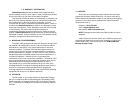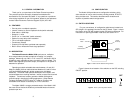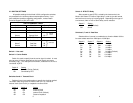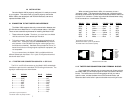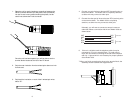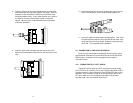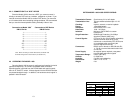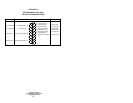
3.2 SWITCH SETTINGS
All possible settings for the Model 1030’s configuration switches
are presented in the summary table and descriptions below. If you
have additional questions regarding configuration, contact Patton
Technical Support at (301) 975-1007.
Switch 1: Not used
Switch 2: Carrier Enable
Switch 2 is used to specify how the carrier signal is raised. In most
point-to-point, full duplex applications, the carrier signal can remain
constantly “high”. In a multi-point environment, contention for the line is
“controlled” by RTS.
Switch 2
Setting
On Constant Carrier (Default)
Off Controlled by RTS
Switches 3 and 4: Transmit Clock
Switches 3 and 4 are used together to specify the clocking method.
The Model 1030 can provide an internal clock (Pin 15), receive an
external clock (from Pin 24), or loopback a received clock.
Switch 3 Switch 4 Setting
On On External Clock
On Off External Clock
Off On Internal Clock (Default)
Off Off Receive Loopback
5
Switch 5: RTS/CTS Delay
After request to send (RTS) is raised by the host terminal, the
Model 1030 raises CTS after a slight delay in order to give the remote
terminal time to receive an incoming signal. Depending on the type of
environment, either a 7mS or 53mS delay can be selected.
Switch 5
Setting
On 7 mS (Default)
Off 53 mS
Switches 6, 7 and 8: Data Rate
Switches 6 thru 8 are set in combination to allow the Model 1030 to
be used at data rates from 1200 bps to 19,200 bps.
Switch 6 Switch 7 Switch 8 Setting
On On On 1.2 Kbps
On On Off 2.4 Kbps
On Off On 4.8 Kbps
Off On On 7.2 Kbps
On Off Off 9.6 Kbps (Default)
Off On Off 14.4 Kbps
Off Off On 19.2 Kbps
Off Off Off 19.2 Kbps
6
SWITCH SUMMARY TABLE
Position Function Factory Default
Switch 1 Not Used Off
Not Used
Switch 2 Carrier Enable On Constant Carrier
Switch 3 Transmit Clock Off
Switch 4 Transmit Clock On
Switch 5 RTS/CTS delay On
7 mSec delay
Switch 6 Data Rate On
Switch 7 Data Rate Off
Switch 8 Data Rate Off
Internal
Clock
9,600 bps
}
}




